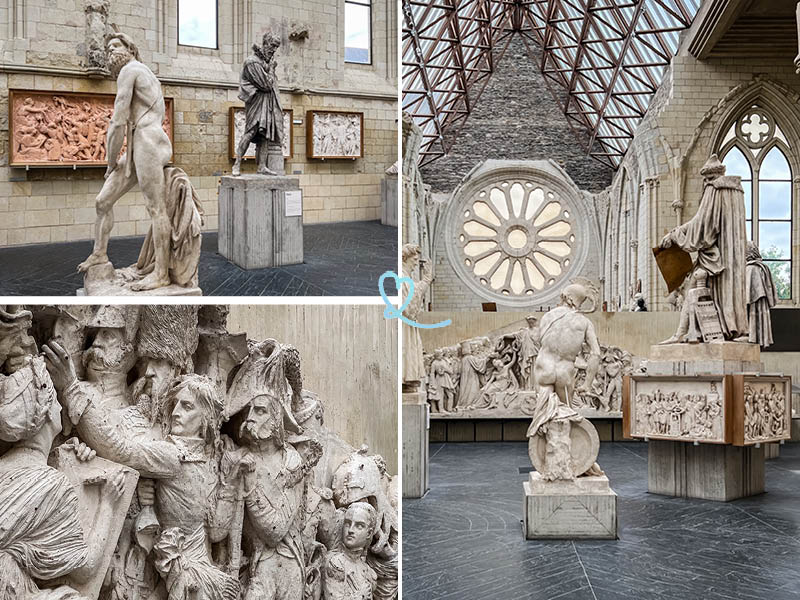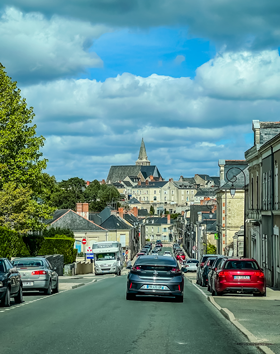Visiting the historic capital of Anjou? Discover the David d'Angers Gallery! Let yourself be surprised by this atypical art gallery, bathed in light thanks to its magnificent glass roof, and immerse yourself inthe fascinating work of the artist. Pierre-Jean David, through his collection of astonishing sculptures.
In this article, you'll find our useful tips for visiting the David d'Angers Gallery and having a wonderful time.

This guide is completely independent, based on our experiences. We visited the region anonymously, making our own choices and paying our bills in full.
Why visit the David d'Angers Gallery?
Is the David d'Angers Gallery worth it? Our opinion:
A real Angers nugget, the gallery is worth a visit for its atypical space in a former church, and for its exceptional and varied collection of sculptures. A visit that's as short as it is captivating!
In our opinion, this is the best museum in Angers. See our list.

Why is the David d'Angers Gallery famous?
The gallery is famous for hosting works by Pierre-Jean David (1788-1956), a celebrated sculptor of the first half of the 19th century. A native of Angers, he changed his surname to David d'Angers in 1820, and is renowned for the precision and virtuosity with which he models his protean, expressive sculptures.

Our favorite moments
A real nugget, we loved our visit to the David d'Angers Gallery for..:
- Discover thecaptivating work of artist David and his collection of expressive, detailed sculptures.
- The jewel case that is Toussaint Abbey in which the collection is displayed, not to mention its exceptional glass roof. You're sure to be mesmerized by the majesty of the whole.

WHERE TO STAY IN Angers
Our favorites: neighborhoods and hotels
Downtown, to enjoy the city, its restaurants and beautiful architecture.
Hôtel L'Oisellerie - see photos and availability
Hotel 21, Foch - prices, pictures and availability
In the surrounding countryside, for greater peace and quiet
Hotel Château des Forges - see photos and availability

History in brief
Before it became an art gallery, the building was a chapel, first appearing in the 11th century, before undergoing various changes:
- 13th century: Toussaint Abbey is built by the canons of Saint-Augustin.
- 17th century: The monastic community expands, leading to the construction of new buildings (prior's dwelling and cloister, still visible).
- 18th century: The choir with the large rose in the gable is added.
- 19th century: The site was confiscated during the French Revolution and, having been completely abandoned, its vaults collapsed in 1815.
- Contemporary period: The building was classified as a historic monument in 1902. It wasn't until 1980 that the city of Angers decided to breathe new life into the abbey ruins and exhibit the work of David d'Angers, previously on display at the Musée des Beaux-Arts. The site was inaugurated four years later by French President François Mitterrand.

Access: Galerie David, Angers (Maine-et-Loire)
Where is the David d'Angers Gallery?
- In downtown Angers, it's one of the city's main attractions.
- 33 bis rue Toussaint
- Close to the Musée des Beaux-Arts
OUR TIPS FOR RENTING A CAR IN Loire
- Compare prices on our preferred platform: DiscoverCars - one of the best rated sites.
- Choose a fairly compact car (many villages have narrowed the road).
- Think aboutfull insurance (parking in big cities is really tight).
- There is a lot of demand, book it early.

How to get there?
There are several ways to get to the David d'Angers Gallery:
- By train: Angers is served by regular connections from major cities such as Nantes (37min) and Paris (1h35). From the station, it's an 11-minute walk to the gallery. See available timetables and book your train tickets now.
- Public transport: The gallery is served by several bus lines (Sainte Croix or Lices stops) and by tramway line A (Foch-Haras or Ralliement stops). You can find the entire public transport network on the city's official website here.
- By car: Angers is well served by the A11 freeway from Paris, the A87 from Tours, or the A10 from Bordeaux.

Parking
The gallery does not have its own parking lot. You can park directly opposite on rue Toussaint, where some 30 paying spaces are available (disabled parking and spaces with plugs for electric vehicles are also available), but since we're right in the center of town, we'd advise you to go to the nearest parking lot, called Ralliement, just a 3-minute walk from the gallery. And if you're on a bike, rue Toussaint also has racks for your trusty steeds.
DISCOVER Angers
- Things to do in Angers
- Where to sleep in Angers: best hotels
- Where to eat in Angers: best restaurants
- Rent a car in Angers
- Visit the Château d'Angers
- Visit the Museum of Fine Arts in Angers - coming soon
- Château de Brissac
- Terra Botanica
- Best castles around Angers
- Most beautiful villages around Angers

Useful tips: duration, schedules, eating...
Best time to visit
The Loire is a popular destination all year round, but particularly in summer and during school vacations. We recommend visiting the gallery in the morning, to avoid the crowds and take advantage of the light flooding through the glass roof.
Length of visit and main difficulties
It will take you between 30min and 1h to discover the gallery, its history, architecture and sculpture collection. No difficulties to report. With the exception of the mezzanine, the site is accessible to people with reduced mobility.

Advice on how to visit
The gallery doesn't propose any particular itinerary, and given that the visit is fairly short, you'll be able to rely on your own eye and go straight to the works that particularly interest you.

A LITTLE MORE patience
All the photos, maps, information, good addresses to make your stay in the Loire Valley a success, will soon be gathered in a single ebook!
If you wish to be informed of the publication of our guide on the Loire, register:

Visiting with children
A visit to the David d'Angers Gallery is both fun and fast-paced, both of which are great fun for kids! There are no documents specifically designed for children, but activities are offered from time to time. Visit the official website here.
Schedules and rates
The gallery is open Tuesday to Sunday, 10am to 6pm, and prices are as follows:
- Full price: €4
- Reduced rate: €2
To find out more about exceptional closing days, please visit the official website here.

Catering
There's no on-site restaurant, but as the gallery is located in downtown Angers, you're sure to find what you're looking for among the plethora of tempting restaurants.
- Just a 7-minute walk from the gallery, Restaurant La Cour serves local cuisine in a friendly, relaxed atmosphere.
- If you just fancy a little sweet break before resuming your visits, you can grab a pastry at Ma petite Boulangerie.
- And if, on the contrary, you feel like taking your time, discover the Milk, Thyme, Salt Restaurant. With a Michelin star, this restaurant will delight your taste buds with its exquisite dishes.
Do you love cooking? Take a look at our article on the city's best restaurants and let our mouth-watering selection be your guide (coming soon).

An art gallery like no other
There are places whose atmosphere immediately envelops us, and the Galerie David d'Angers is definitely one of them! You'll be as enchanted by the abbey church as by the magnificent collection of sculptures it houses.
A place steeped in history
Before entering the building, take time to admire the slate roof and the walls of tuffeau, the typical stone of Loire châteaux. It's rare to be able to admire a museum from the outside too. You'll also be charmed by the magnificent Gothic rose that stands proudly before you. But the show is all about the interior. As soon as you enter the building, you'll be struck by the light that floods the space through the formidable glass roofs. Designed to enhance the beauty of the statues, they add a majestic touch to the setting.

Pierre Prunet, the chief architect of the Monuments Historiques who renovated the David d'Angers Gallery, wanted to highlight the history of the site. If you pay close attention, you'll see the remains of pillars collapsed in the 18th century and left as they are on the ceiling. You'll also notice the harmonious blend of materials. Local slate and tufa stone are blended with more contemporary components such as wood, concrete and glass for the skylights. This material was chosen by Prunet to recall the light when the building was in ruins, but also to evoke the atmosphere of sculptor David's studio. In addition to the beautiful light, we also loved the perspective offered by the gallery and its series of curved arches, giving it a certain lightness.

A soothing space
Once you've had time to appreciate the gallery's unique architecture, you can discover the masterpieces it contains. We were particularly taken by the little details that made the visit so original, such as the fact that the sculptures had their backs to us. We enter through the exit, which may seem intriguing, especially when you're used to seeing the collections from the front. However, wandering around them allows us to really focus our attention, and the sculptures take on their full significance.

Another detail that really appealed to us was the fact that most of the sculptures were not placed at the visitor's level, but rather overhanging them. This little twist in the scenography, too, lends a certain breadth to the works and makes for an astonishing visit. These two details, coupled with the lighting, give the place a magical aura, and we're sure you too will be enchanted by the unique atmosphere of the David d'Angers Gallery. If you're looking for another unusual museum, we recommend the Musée Jean Lurçat, with its magnificent tapestries.

David d'Angers in the spotlight
But who is this David d'Angers we're talking about? He was a brilliant sculptor from Angers in the second half of the 19th century, not to be confused with the other famous David of his time, who was a painter and leader of the neo-classical movement.
Immersion in the world of David d'Angers
The first thing that struck us about this "unlike any other" gallery is that the collection features sculptures mainly in plaster. These are workshop models that were later used for marble or bronze. These are genuine originals, chiselled by the hands of the artist himself, and we found them particularly touching. In fact, David d'Angers was renowned for the precision with which he embodied his characters, particularly his strikingly realistic portraits. A fervent republican and defender of human rights, the artist modeled the faces of contemporaries (artists, politicians, scientists) he admired, and his political commitment was reflected in his choice of these figures.

We also really appreciated the fact that we could access all of David d'Angers' work and appreciate the different facets of his corpus. You'll be able to see both his iconic sculptures (in the nave) and his early works (in the abbey church), not forgetting the astonishing gallery of portraits on the mezzanine! You'll find a cross-section of the faces of some of the world's greatest figures, including Victor Hugo and Napoleon Bonoparte. Finally, don't miss the showcases under the mezzanine featuring the artist's preparatory drawings (photo below). Nearly 4,000 drawings are in the collection and are presented in rotation, due to their fragility. These drawings are a real complement to the sculptures on display, providing an insight into David d'Angers' creative process.

Focus on remarkable works by David d'Angers
What stands out in this collection is David d'Angers' incredible variety of styles. He was equally adept at handling historical subjects with force, while also immortalizing faces with uncanny precision. In the nave, it's impossible to miss the statue of Jean Bart, the famous 17th-century privateer, brandishing his sword to rally his soldiers. Look at how detailed and lively his outfit is, and how much the artist admires his character. This magnificent plaster cast prefigures the bronze statue that now stands on Dunkirk's Place Jean-Bart, erected on an imposing 6m-high pedestal. Created in 1845, this work is one of forty monumental sculptures commissioned by various French cities.

Just opposite the statue of Jean Bart, you can admire the Panthéon Fronton, which closes the first part of the exhibition. Produced between 1830 and 1837, it was this work that established him as an official and recognized sculptor. What detail in this sculpture! If you look closely, you'll see that the figures at the ends are smaller, creating volume and upward movement towards the central figure. This figure of a woman topped with stars represents the Patrie and gives wreaths of laurel, a flower symbolizing victory and distinction, to the men who have taken part in France's history. We loved detailing this multi-faceted work, which shows David d'Angers' admiration for those who defend freedom.

Finally, in the former choir of the abbey church, you'll find one of David's early works, entitled Jeune Grecque. This is a plaster cast used to create the sculpture for the tomb of Marco Botzaris, one of the main protagonists of Greek independence. In our opinion, this is one of the most disturbing statues in this collection. We particularly liked the contrast between the person to whom this statue is dedicated (a wartime general) and its motif (the innocent, fragile body of a little girl). How moving it was to see the sadness in this little girl's eyes as she followed the "Botzaris" inscription on the tombstone with her delicate fingers.

Before being sent to Greece, this piece was exhibited at the Salon in Paris in 1827. It both fascinated and shocked critics, who saw the crude depiction of the teenager's body as sacrilegious. Yet this choice is not insignificant, since adolescence, symbolizing the passage from childhood to adulthood, recalls the state of 19th-century Greece, still under the yoke of the Ottoman Empire. This statue is therefore a magnificent allegory, i.e. an idea that takes the form of an image. We therefore strongly recommend that you take the time to observe each of the statues and ask yourself what lies behind their perfect execution...
Subscribe to our Newsletter
- Get away from it all with Region Lovers' beautiful destinations!
- Once a month
- Advertising-free
Frequently asked questions
What activities are on offer at David d'Angers Gallery?
Various activities are offered on an ad hoc basis for young audiences. Your children are looked after by mediators for 1h30 and can take part in modeling workshops (11-15 years), investigations with challenges (7-12 years) or a treasure hunt (4-6 years). You can find the full program on the website's agenda page here.
What to do around the David d'Angers Gallery?
Ideally located, the David d'Angers Gallery is the perfect starting point for an enriching afternoon. After your visit, you can:
- Take a look at the Cloître Toussaint just to the left of the gallery,
- Stroll through the charming garden of the Musée des Beaux-Arts and give yourself a vitamin boost by looking at the statue by Nikki de Saint-Phalle (photo below),
- Push open the door of the Musée des Beaux-Arts and discover its magnificent collection,
- Finish with a stroll through the medieval center of Angers.
You'll soon be able to discover all these nuggets in new articles! And if you're in the mood for chivalry, you can read our article on the beautiful châteaux around Angers here.

What's the difference between the gallery and the Angers Museum?
They're both cultural venues in downtown Angers, but nothing really connects them. The David d'Angers Gallery is a former abbey church entirely dedicated to exhibiting the work of the artist of the same name, who in 1811 bequeathed his works to the town in gratitude for the pension he received for his studies. The Musée d'Angers, on the other hand, is housed in a former town house and boasts a much larger collection. The tour covers more than 3,000m2 and includes a section dedicated to the history of Angers and a section dedicated to the Fine Arts, with more than 300 pieces (paintings, sculptures and objets d'art) ranging from the Middle Ages to the present day.
PLAN YOUR TRIP IN
Loire Valley
The castles of the Loire Valley

Other places to explore







